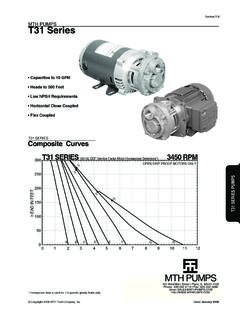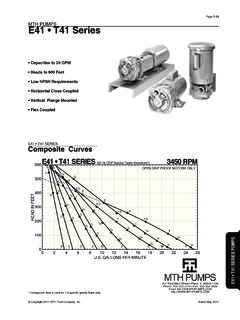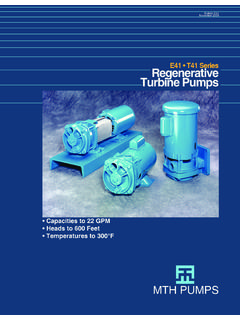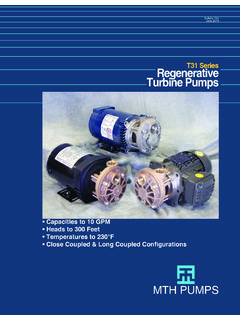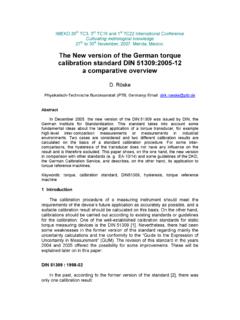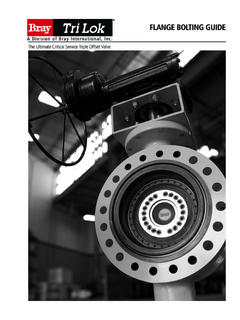Transcription of Pump Manual - MTH Pumps
1 T31 SERIES Section T31 Page 501 Dated July 201597-4621-01-588 Pump ManualHORIZONTAL CLOSE COUPLEDFLEXIBLE COUPLED!WARNING:CANCER AND REPRODUCTIVE HARM SERIESG eneral InstructionsCLOSE COUPLED PUMPSFLEXIBLE COUPLED PUMPSA. Inspection of EquipmentB. StorageC. Placing Stored Pumps Into ServiceD. Application ConsiderationsE. Recommended Spare PartsWhen properly installed and given reasonable care and maintenance, re-generative turbine Pumps should operate satisfactorily for many years. Because of the high differential pressures expected in a regenerative turbine pump, close running clearances are used to reduce internal losses. Abrasive particles, even microscopic ones in high enough concen-trations can open up the close clearances between internal cavities. For critical services it is recommended that you keep an identical pump for stand-by Inspection of EquipmentImmediately upon receipt of the shipment, inspect the equipment for damage or missing components.
2 Check the shipping manifest and report any damage or short-age to the Transportation Company s local agent. Inspect the crate and any wrapping material before discarding. Parts or acces-sories are sometimes wrapped individually or fastened to the skid. Put the instructions that came with the shipment in a safe place where they will be available to those who will be using them for installation and StorageIf the pump is to be stored before use, it should be inspected as described in 1A, re-crated and stored in a dry location. Standard shipping containers are not suitable for outdoor storage. In some areas, it may be necessary to cover the pump s exterior surface with oil or other rust inhibiting coating. All units are tested at the factory with a water/corrosion in-hibitor solution, some of which will remain inside the pump upon receipt. If units are flushed out prior to storage, this inhibitor will be removed and proper care must be taken to prevent product deterioration from improper storage beyond 30 days, a corrosion inhibiting protective fluid should be added to the internal pump cavities.
3 Fluids used in the pump should be selected for com-patibility with pump materials. This is very important when optional seal and gasket materials have been used. Protective caps on the inlet and outlets should also be used. Caps alone are not sufficient Placing Stored Pumps Into ServiceSpecial care must be taken when placing stored Pumps into service. First clean the outside and flush out the inside with a process compatible fluid. Try to turn the pump using the coupling or shaft. On close coupled units, access to the shaft is between the pump and motor. A vise grip or other plier type gripping device may be used directly on the shaft. Applying torque to the motor fan blades is not recommend-ed. If the impeller does not break loose immediately, fill the pump with a process compatible fluid and try again in a few this fails, loosen only the pump cover thru bolts clamping the assembly together, one full turn, no more.
4 Fill the pump with fluid. Apply torque, 50 foot pounds maximum, to the shaft. The pump should turn before 50 foot pounds is reached. If you are successful at breaking loose the unit, continue turning the pump while re-tightening the thru bolts to their original the unit still won t turn over, DO NOT ap-ply further force. Refer to the Disassembly/Reassembly Instructions in Section 5 to determine the cause of the Application Considerations1D1 Electrical WiringAll electrical equipment and wiring should conform to Local and National Electrical Codes. Use the motor manufacturer s instructions for connecting the motor. Note the correct rotation and wiring diagrams on the assembly. Make sure the motor rotation and speed matches that required for the pump. When making electrical connections to motors provided with threaded stud electrical terminals, the recommended torque should be 13-16 inch-lbs.
5 Applying torque in excess of this range may cause Construction MaterialsWhile it is reasonable to assume that good judgment has been used in selecting all the materials in the pump for compatibil-ity with process fluids, actual conditions sometimes vary from original expec-tations. Also, typical material selection charts do not consider all the temperature, pressure, and fluid variables. The custom-er s engineer should be consulted for final judgment on the best materials for critical process ValvesThe first valve to be considered for a regenerative turbine pumping system might be a pressure relief valve. Because this type of pump has a horsepower requirement similar to that of a positive displacement pump (constantly rising along with a pressure increase) a relief valve can be effectively used to lim-it horsepower. This is helpful when a non-overloading motor is specified.
6 It can be of critical importance if the system flow rate can vary widely. There are almost no circumstances where a flow modulating valve will work successfully in a regener-ative turbine pumping system. The steep pumping characteristic, typical of these Pumps , produces very large pressure changes with small variations in flow rate. As a result, the modulating flow from the valve introduces sharp pressure shock waves that shorten pump life and may cause damage in other pieces of equip-ment in the a shutoff valve is necessary in the suction line, use a gate, ball, butterfly, or other full port valve. Globe or other flow restricting valves can in some cases reduce pump flow or increase chances of swing check valve is recommended in the suction line even when the pump inlet is only slightly higher than the fluid source. It should be the same size as the pump inlet or sized based on reasonable fluid friction foot valve is recommended when lifting fluid from a sump.
7 This will save wear and tear on any pump, even those equipped with self priming Y-Strainer is recommended immediately ahead of the pump on any newly con-structed system. This is advisable due to the probability that foreign material large enough to damage pump clearances may remain even though the piping has been in the outlet piping of a regen-erative turbine pump should always be open as far as possible when the pump is started. This will reduce the start-up load on the pump and motor. Never start the pump with the discharge valve valving should be open when starting any pumping system. Without some fluid in the pump, it can gall and lock up im-pellers. Violent pump failure will result from continued operation with the inlet valve PrimingRegardless of whether self-priming equipment is used or not, always fill the pump and vent it of air for best seal and pump life.
8 Under most circumstances, regenerative turbine Pumps can be made to self-prime as long as a small amount of fluid can be recirculated through the impeller and the fluid doesn t heat up NPSH (Net Positive Suction Head)The NPSH required varies with every size and capacity of pump. The NPSH required by your unit can be obtained from the performance curves or from your MTH the NPSH available is not equal to or greater than that required by the pump, 502!WARNING:CANCER AND REPRODUCTIVE HARM 503it must be increased or a different pump selected. The usual method for increasing NPSH is to raise the static head on the pump inlet, (Hs).By definition, NPSH means: net positive suction head above the vapor pressure of the pumped liquid available at the centerline of the pump. It should always be given in feet of pumped liquid. The NPSH is actually a measurement of the amount of energy available in the pumped liquid to produce the required absolute entrance velocity in the pump.
9 If a pump requires more energy (or NPSH) than is available at a given capacity, the pressure at the in-let will fall below the vapor pressure of the pumped liquid and loss of performance will = Pressure in the suction vessel in = Vapor pressure of the pumped fluid in = Static height of the pumped fluid above (+) or below (-) the centerline of the = All friction losses from the vessel to the = ( )+ Hs- HfFor boiling liquids, Ps and Pvp are equal. This item then becomes zero and can be omitted from the NoiseRegenerative turbine Pumps typically pro-duce a high pitched whine that increases in intensity as the differential pressure pro-duced in the pump increases. While high frequency sound is attenuated more easily than lower frequencies, piping structures and the fluids in them readily transmit noise. Motors, bearings, and other rotating components add to noise and sometimes create objectionable pump installation can contribute to noise reduction.
10 Proper alignment of the pump and driver is supports for the inlet and discharge piping is equally important. A degree of noise reduction may be obtained when the pumping unit is sup-ported free of building structures by the use of vibration isolators, flexible piping and conduit connections. Elastomer type couplings are the best choice to separate motor noises from the fluid and piping FreezingWhen ambient temperatures drop below the freezing point of the fluid in a pump, consideration should be given to heating, insulating, or draining the pump. If you choose draining the pump, and it will only be for a short period, first remove the drain plugs and drain the lines to and from the pump. Carefully blow out the pump with compressed air to clear all internal cavities of - Pvpsp. Recommended Spare PartsFOR CRITICAL SERVICES - a duplex in-stallation, with two identical pumping units in parallel, is the safest and many times the most cost effective IMPORTANT SERVICES - a standby pump, ready for installation is pricing and new pump warranty is offered for factory rebuilding.


